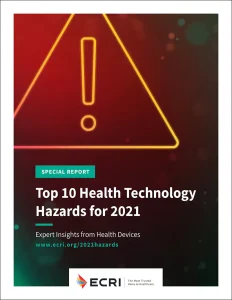Article provided courtesy of ECRI
An independent, nonprofit organization focused on improving the safety, quality and cost-effectiveness of healthcare worldwide, over the past 50 years, ECRI has grown to provide guidance on technology selection, evidence assessment and patient safety to thousands of hospitals and healthcare organizations.
As part of its work, it regularly performs hands-on testing of medical devices and related technologies in labs located in Plymouth Meeting, Pennsylvania, and Kuala Lumpur, Malaysia. For the past 14 years, it has published an annual Top 10 Health Technology Hazards list. The following Q&A discusses the latest list and its relevance to the UV and healthcare communities.
What is the Top 10 Health Technology Hazards list? How are topics selected?
 The annual Top 10 list is published to identify the potential device-related risks ECRI believes to warrant the greatest attention for the coming year. It also provides practical recommendations to guide healthcare facilities in reducing these risks. Topics are nominated for consideration by engineers, scientists, clinicians and other patient safety analysts based on their own expertise and insight. Staff also consider the thousands of health-technology-related problem reports received through ECRI’s Problem Reporting Network, along with data submitted to the patient safety organization. To narrow the list and select the final 10, a committee assesses the impact of each hazard, considering factors such as the severity of consequences, the expected frequency of occurrence and the relevance to various types of healthcare providers.
The annual Top 10 list is published to identify the potential device-related risks ECRI believes to warrant the greatest attention for the coming year. It also provides practical recommendations to guide healthcare facilities in reducing these risks. Topics are nominated for consideration by engineers, scientists, clinicians and other patient safety analysts based on their own expertise and insight. Staff also consider the thousands of health-technology-related problem reports received through ECRI’s Problem Reporting Network, along with data submitted to the patient safety organization. To narrow the list and select the final 10, a committee assesses the impact of each hazard, considering factors such as the severity of consequences, the expected frequency of occurrence and the relevance to various types of healthcare providers.
Who is the intended audience, and how do they use the list?
The primary intended audience is healthcare delivery organizations. The goal is to raise awareness of preventable safety risks and to help organizations prioritize their efforts to mitigate these risks. The list is frequently cited by researchers and device manufacturers who are trying to improve the standard of care through education and technological development.
What are some of the themes this year?
This edition of the Top 10 list was developed under the shadow of the COVID-19 pandemic. As a result, the need to move from coping during an emergency to building stronger and more resilient processes is a recurring theme on the list.
Which issues are at the top of the list? How does this compare to last year’s list?
This year’s number one Health Technology Hazard focuses on the “Complexity of Managing Medical Devices with COVID-19 Emergency Use Authorization (EUA).” The FDA has authorized hundreds of medical devices and supplies for temporary use during the pandemic. Healthcare facilities that use these EUA devices now face the challenge of managing inventories of EUA devices and determining what to do with these devices once the EUA ends.
Other topics arising from COVID-19 include the rapid implementation of telehealth technologies that may not have the appropriate infrastructure or strategy in place to ensure long-term success, the use of KN95 respirators from China that do not provide the level of filtration advertised, the use of unproven consumer-grade devices in medical decisions, and concerns related to hasty deployment of UV disinfection technologies.
All topics on the list in 2021 are new. However, there have been some trends in recent years, including a focus on medication errors and cybersecurity. Several topics in 2020 and 2021 also have covered rapid adoption of new technologies, which outpaces the safeguards intended to keep patients and staff safe.
Why include UV disinfection technologies on the list this year?
It was decided to include this topic for 2021 because of concern that the rapid, pandemic-driven expansion of the market that occurred in 2020 – which includes the use of UV disinfection technologies for novel applications or by inexperienced users – may result in misuse and poor execution of disinfection programs. The need to combat the SARS-CoV-2 virus has prompted healthcare facilities, public health officials, private companies and consumers to consider UV disinfection technologies for many new applications. Just among healthcare organizations, interest in purchasing UV room disinfection technologies doubled between 2019 and 2020, as measured by the number of pricing quotations ECRI analyzed for its member organizations. Dozens of questions have been received about the technology, including requests for information on consumer-grade devices available to the public. The potential for errors and misuse resulting from hasty deployment of UV disinfection devices prompted the selection of this topic.
What are the risks associated with UV disinfection? How do they compare with the risks of other disinfection technologies?
With UV disinfection technologies being considered for use in many new environments, and by users with little experience with UV light or disinfection processes, the chances for error or misuse are high. Risks include exposure of the operator or bystanders to unsafe levels of UV light, as well as compromised device effectiveness against the SARS-CoV-2 virus and other infectious organisms. The risk of both of these negative outcomes is increased when guidance from the device manufacturer is inadequate, and when users don’t understand proper application of the device in terms of device positioning, exposure times and safety features.
Other supplemental disinfection technologies, such as hydrogen peroxide vapor and electrostatic disinfectant sprayers, have their own risks associated with use. Frequently, these risks relate to exposure to unsafe levels of toxic chemicals. However, there hasn’t been as much interest in these technologies as in UV disinfection, possibly in part because these devices require more hands-on work or longer room turnover times. They also aren’t as accessible to purchasers outside of the healthcare market, such as public facilities and consumers. UV disinfection was chosen because of its wide applicability.
What are the potential risks compared to the potential benefits of UV disinfection technologies?
UV disinfection technologies can be an effective supplement to normal manual cleaning and disinfection processes. UV light can help to ensure consistent coverage of surfaces and provide some benefit for locations where it is not realistic to manually disinfect every surface. Some applications of UV disinfection can provide additional benefit by inactivating organisms in the air, which traditional chemical disinfecting wipes cannot achieve. However, UV disinfection is not a good fit for every application because it requires an investment of time and energy to get it right and to make the most of the technology. If an organization or an individual is not willing to invest that time, then the risks and the costs may outweigh the benefits.
How might some of these risks be mitigated?
Unfortunately, there are no shortcuts with UV disinfection. Purchasers need to take the time to define their goals, consider the various types of devices that are available to them and select the device or devices that best meet those goals. From there, they will need to invest in appropriate training for their staff and/or properly installing the devices. Choosing a device manufacturer that demonstrates a willingness to work with them and to understand their needs may help set their program on a path for long-term success.
Organizations that are considering implementation of UV disinfection technologies should assign oversight to an appropriate program manager. The program manager should thoroughly vet potential vendors before selecting a device and should develop a detailed, written protocol for use in accordance with UV and medical device manufacturer instructions for use. The program manager also should continue to monitor use of the device as time goes on and should ensure that device operators receive the necessary training and periodic refreshers.
Consumers who choose to use UV disinfection should practice caution when selecting a device. They should look for devices that clearly specify the wavelengths that are used and that provide adequate guidance on how to use the device safely and effectively for their desired application. They should be skeptical of devices that claim to clean (that is, to remove soil) or to sterilize (that is, to destroy or eliminate all forms of microbial life). UV light alone cannot achieve these goals. The public also should be wary of claims made by companies or organizations that use UV disinfection technology, like hotels and mass transportation services. Although UV may help reduce the level of environmental bioburden, no public location is 100% free of microorganisms, so the public should continue to take precautions such as wearing a mask and washing their hands frequently. Fabrics and other porous materials are particularly difficult to disinfect with UV light.
Manufacturers can facilitate device selection by providing clear and meaningful information about their product – specifications on the wavelengths and intensity of UV light emitted by the device, details on available safety features, and clear examples of how the device can be used safely and effectively, including typical exposure distances and times. When working with a customer, vendors should take care to understand the expected use case, the typical workflow of the environment and potential pitfalls before recommending a protocol for use of their device.
Are there any actions already underway to mitigate the risks mentioned?
IUVA has a working group that is collaborating to develop standards for UV disinfection device performance. If successful, these standards may go a long way toward helping healthcare facilities and other purchasing organizations to compare device performance in a meaningful way. Consumer-grade devices also should be held to performance standards to reduce the risk of counterfeit or otherwise ineffective or unsafe products on the market.
How can readers see the Top 10 Health Technology Hazards list for themselves?
The Executive Brief is available to the public. It can be downloaded for free at www.ecri.org/2021-top-10-health-technology-hazards-executive-brief/.
ECRI members can access the full version of the Top 10 Health Technology Hazards list at www.ecri.org/components/HDJournal/Pages/2021_Top_10_hazards.aspx.
Additionally, ECRI hosted a webcast on Feb. 17 to briefly discus the list and to provide in-depth information about this year’s number one topic: the management of Emergency Use Authorization medical devices. Recordings can be accessed at www.ecri.org. Several episodes will be devoted to ECRI’s Smart Healthcare Safety podcast series to topics on the list. The podcast contents listing is available at
www.smart-healthcare-safety.ecri.orgwww.smart-healthcare-safety.ecri.org.




